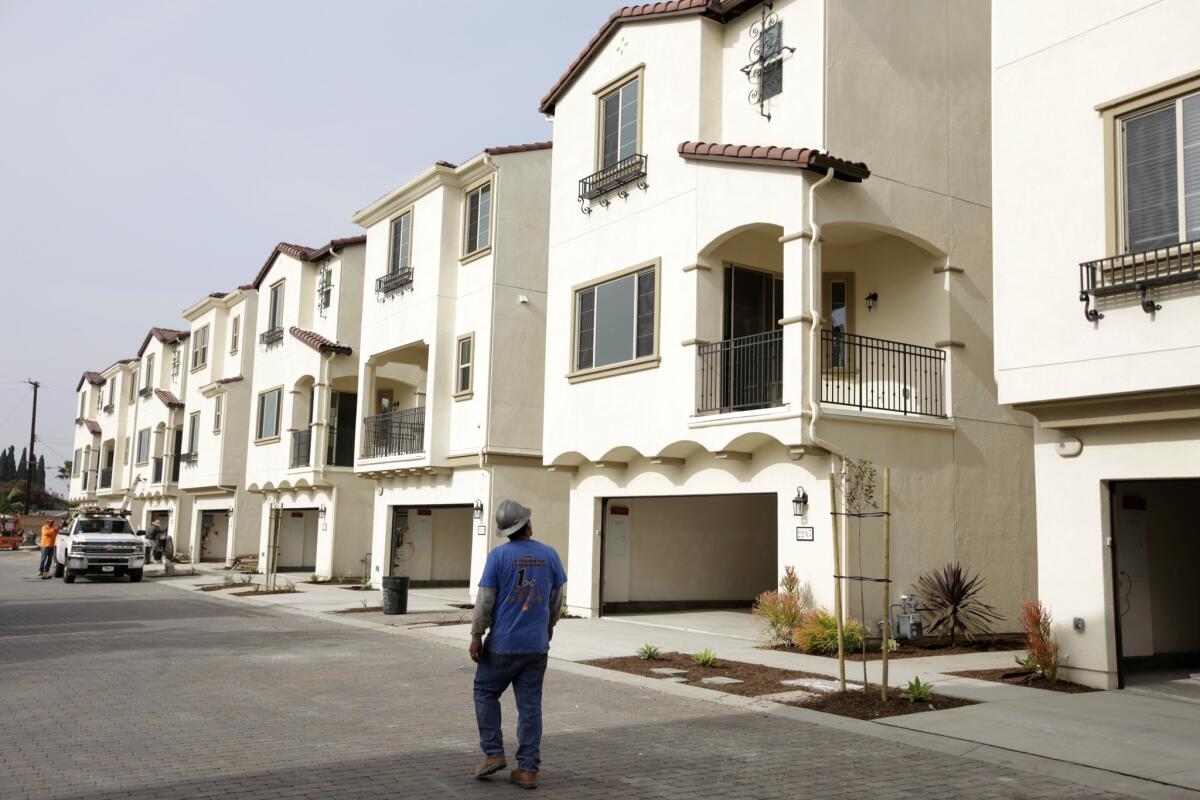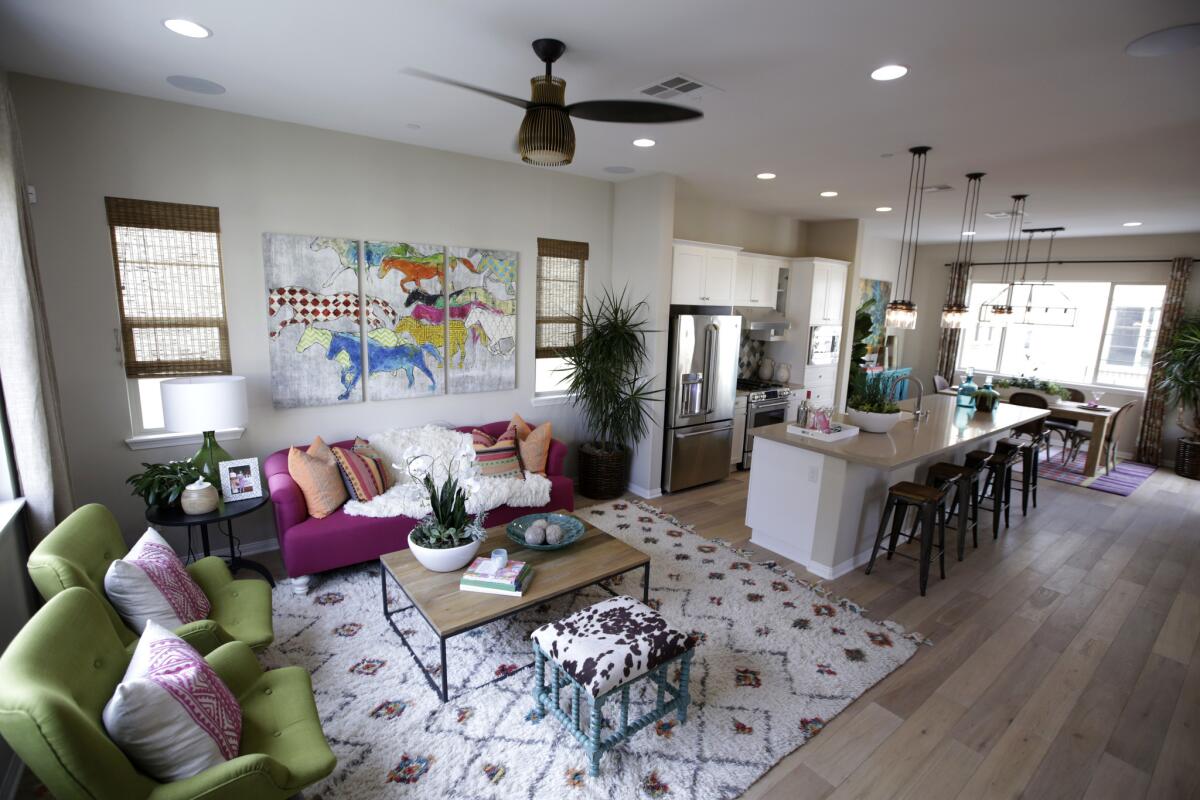One solution to Southern California’s housing crisis: building in tight spaces, small lots

In Santa Ana, not long ago, on a tired commercial stretch west of downtown, stood a church, a burnt-out motel and something harder to see: one key to alleviating the region’s housing crisis.
It’s on this now-graded site near the corner of 1st and Bristol streets where Olson Co. is constructing 62 residences expected to start in the low $400,000s.
But the Seal Beach firm’s Ventana Walk project isn’t a traditional Southern California housing tract, nor is it the kind of massive multifamily complex that has been a perennial favorite of developers.
Instead, it’s a bit of both: a tightly spaced “infill” development of town homes squeezed into just two and a half acres — making it an affordable housing option in a region where many young families can’t afford to buy a traditional new home.
Much of today’s residential development has been focused on city centers, such as in Los Angeles where thousands of apartments and condos aimed at young professionals are being built in towers mushrooming in downtown.
But experts say the regional housing shortage also needs to be addressed by building more infill developments in outlying communities, where many families might prefer a town home or small house to an urban high-rise.
“We can’t fit everyone into downtown Los Angeles,” said Hasan Ikhrata, executive director of the Southern California Assn. of Governments, a planning agency that estimates the region needs at least 600,000 more housing units just to meet today’s demand. “These types of housing developments become very important. They provide the variety of housing we need.”
There’s plenty of room for them in Los Angeles and surrounding counties, where an abundance of vacant lots, run-down warehouses and struggling strip malls could be redeveloped into the type of town home and mini single-family communities Olson and others are now constructing.
“We always seem to be demolishing something,” said Scott Laurie, chief executive of Olson, which has about a dozen communities in the region under development.

In Los Angeles, town home-like developments have proliferated in recent years after the City Council passed an ordinance to encourage the development of small lots into mini subdivisions of houses only inches apart.
The “small lot” homes sell for top dollar in hip neighborhoods such as Venice, Silver Lake and Los Feliz, where homes in a recent project are starting above $1 million.
But many of these recent infill developments are outside such areas as Los Angeles’ Westside or Orange County’s Newport Beach with pricey real estate. That’s enabling builders to sell the homes in communities including Anaheim, Gardena and Van Nuys for $400,000 to $600,000 — somewhat affordable, at least by regional standards.
The median new home price in Orange County by comparison was $934,250 in October. In L.A. County, the median was $571,000 and would have been higher if sales of low-cost Antelope Valley tract homes weren’t included, according to CoreLogic.
Often times, the projects are popping up in communities that have had little to no new housing for years.
TRI Pointe Homes, for example, is building more than 100 town homes on the site of a demolished El Monte car dealership. The Irvine builder expects to start the units in the mid-$400,000s — similar in cost to its four-bedroom houses 30 miles east in San Bernardino County’s master-planned Ontario Ranch.
Tom Grable, Southern California division president for TRI Pointe, expects the El Monte homes to go fast.
“You look at the San Gabriel Valley, there just aren’t that many opportunities” for new homes, he said. “Town homes in the $400,000 range have their appeal.”
The prices make the developments popular with young families looking to own a new home but stay close to parents, jobs and entertainment.
Rick Fletcher, vice president of sales at Irvine-based MBK Homes, said half the buyers at its new Anaheim single family and town home community are under age 40.
That includes Jenn Trinh, 39, who this year purchased a $480,000 three-bedroom town home at the community, where a motel once stood.
Trinh and her husband had previously owned a four-bedroom home in the Inland Empire. But they got into trouble in the recession, went through a short sale and moved back to Orange County, where they both grew up and worked.
By the time they rebuilt their credit and were ready to buy again, they decided to stay put — unwilling to make another long commute. In October, Trinh, her husband and two young children moved into their new town home across from a Brookhurst Street strip mall.
“I just wanted to be close to everything,” Trinh said. “I work in Fullerton. All my family is either in Anaheim or Garden Grove.”
Infill development has occurred for decades, but at a smaller scale, said Pete Reeb, a principal with John Burns Real Estate Consulting.
In previous hot markets, developers could more easily build sprawling master-planned housing tracts in Orange County, Santa Clarita and the Conejo Valley or turn a quick profit by constructing houses farther out in the Antelope Valley and Inland Empire for buyers willing to stomach a long commute
But land near the coast is now scarce, and in outlying areas of Riverside and San Bernardino counties, home prices remain below last decade’s peak, while construction costs are higher, Reeb said.
That’s made it harder for builders to make a profit, causing them to turn inward.
“I have been in the industry 30 years and it’s really only been in this cycle where the true kind of adaptive reuse, infill development, has really started to take off,” Reeb said.
KB Home is one builder that has long specialized in master-planned suburban housing tracts that’s turned toward infill production. Currently, the Westwood company is selling town homes around $500,000 in Downey and Gardena, as well as small-lot homes in Van Nuys for the same price.
“There is just increasing demand,” said Glen Longarini, division president for Los Angeles and Ventura counties. “It’s a good spot to be for a builder.”
Economists have long said the chief culprit behind California’s affordability crisis is there isn’t enough homes for all the people who wish to live here.
But Richard Green, director of the USC Lusk Center for Real Estate, warned that even ramping up infill development won’t be a panacea for Southern California’s housing woes given the region’s diverse economy and attractive climate.
“But I think it would be less bad — I would even say a lot less bad,” Green said.
Getting even that far could be tough. Approvals for denser infill projects can be challenging, especially since the available land often borders traditional subdivisions that blossomed during the region’s great post-war boom.
Take Costa Mesa. The city, perched on a mesa east of the Balboa Peninsula, had become a hot spot for new dense single-family, town home and apartment communities.
But in November, residents fought back and overwhelming approved a ballot measure to require voter approval for certain large projects that need a zone or general plan change.
Jay Humphrey, a longtime resident who promoted the measure, said the community was concerned about traffic and out-of-character projects — such as three-story town homes with roof decks that loom over one-story houses.
“We have a city that is mostly built out and it has an infrastructure really set for significantly less dense housing,” said Humphrey, who waged a losing battle for a council seat.
Other cities have similar ballot-box zoning rules and at times residents have been accommodating.
That includes Monterey Park, where builder Olson paid $80,000 to fund a 2014 special election in which voters narrowly approved its plan to build 80 homes on a nine-acre nursery site.
Last year, Olson held a weekend grand opening during which 400 people toured the single-family home community.
The homes sold briskly and when the last phase opened in September, Olson had lifted prices by about $50,000 for the homes, which started between $550,000 and $668,000.
As of mid December, there was only one house left.
Follow me @khouriandrew on Twitter
ALSO
The last days before Christmas may be busy, but unpredictable, for retailers
Three skyscrapers planned near L.A. Live in downtown Los Angeles by Chinese developer
More to Read
Inside the business of entertainment
The Wide Shot brings you news, analysis and insights on everything from streaming wars to production — and what it all means for the future.
You may occasionally receive promotional content from the Los Angeles Times.











